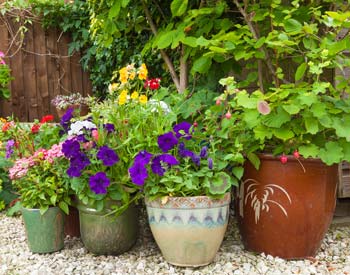Container Gardening
Find out which type of container gardening works best for you.
Searcy, Ark. – Many White County residents have limited space to garden. Outdoor pots can be "landscaped" just like the rest of your outdoors. And these planted containers can be worked into your larger landscape to dress up existing plantings.
One way to heighten the drama of these two features is to place the containers by the front door. Plantings such as pink mandevilla, skirted in English ivy can be made to compliment a border of hardy garden mums and a basket of blooming ivy geranium.
Container gardens can be planted in three distinct ways:
1. ’Bouquet containers’, which combine three or four plants in one pot to create contrast, color, and grace.
2. ’Accent containers’, which feature a prominent, eye-catching plant not usually seen in pots, such as a shrub rose or even an evergreen tree.
3. ’Moveable gardens’, a collection of different sized pots and plants that look
good on their own, but also complement each other, creating added visual impact.
Maybe the most endearing attribute of container planting is its mobility. This feature
can be exploited to make you seem to be a better gardener than you actually are.
Pots can be rotated, with showy blooming containers coming to the front while those which have finished blooming are moved to a restorative site. Groupings can be shuffled around, like rearranging furniture, for altogether new looks. If company's coming tomorrow and your containers are not just so, it's easy to zip out an underwhelming or underperforming plant and plop in a replacement flower that just happens to be in full glory. Container colors cheer up the places you spend the most time, such as chaise-side in the backyard.
A flowering bouquet is lackluster if it isn't flowering. To avoid container lulls, plant flowers that stay in bloom for extended periods like lobelia, an extended bloomer that thrives in partial sun. You can tuck vegetables such as strawberries, tomatoes, parsley, and pepper into your bouquets of lobelia, viola, petunia, and dahlia, but they are heavy feeders and need extra fertilizer.
By grouping plants according to their cultural needs, you will accomplish two things:
- you will assure that they grow and thrive
- you will make your life a whole lot easier
Pro Tip: Add Slow-Release Granular Fertilizer
In potting up your containers, add a slow-release granular fertilizer to the potting mix. It's a great time saver and a bit of an insurance policy.
1. First, cover the drainage hole with pebbles, broken clay pots, or packing "peanuts." The peanuts make the completed pot lighter and easier to transport. Make sure to use the truly peanut-shaped little noodles, not the concave or hollow ones, which will hold water and possibly rot roots. Fill with potting mix to planting depth.
2. Plant the central upright plant, which is the tallest one. If the pot is to be shoved up against a wall or backdrop, put the tall plant in the back.
3. Plant the skirt. Add soil and position low trailers and cascading plants around the edge.
4. Tuck in mid-level plants, sweeping around your star-performer and rising to greet it. Water thoroughly, avoiding blooms and leaves, when possible. Add more soil if settling occurs and remember to deadhead (remove spent blossoms) as the season progresses.
Check out the AR Foods blog post on "salsa" container-gardens.
By Sherri Sanders
County Extension Agent - Agriculture
U of A System Division of Agriculture
Cooperative Extension Service
2400 Old Searcy Landing Rd. Searcy, AR 72143
(501) 268-5394
ssanders@uada.edu